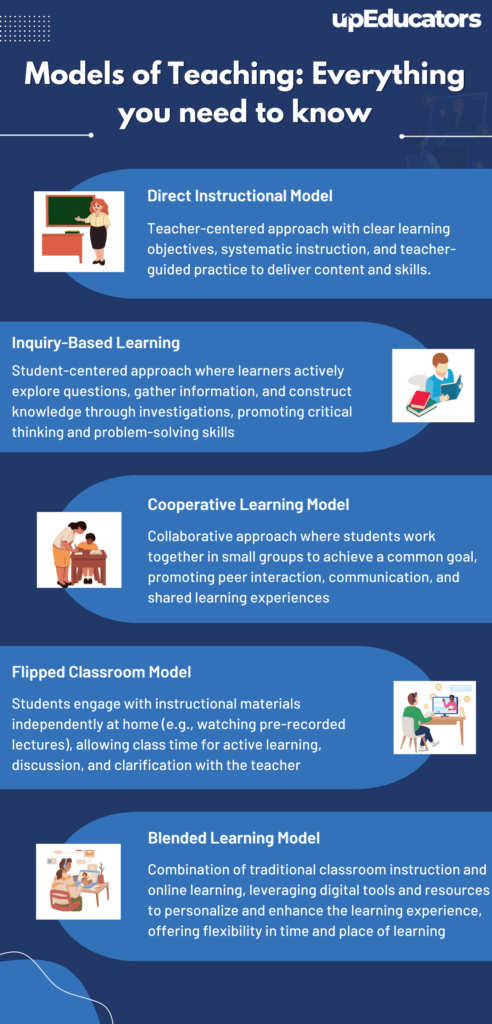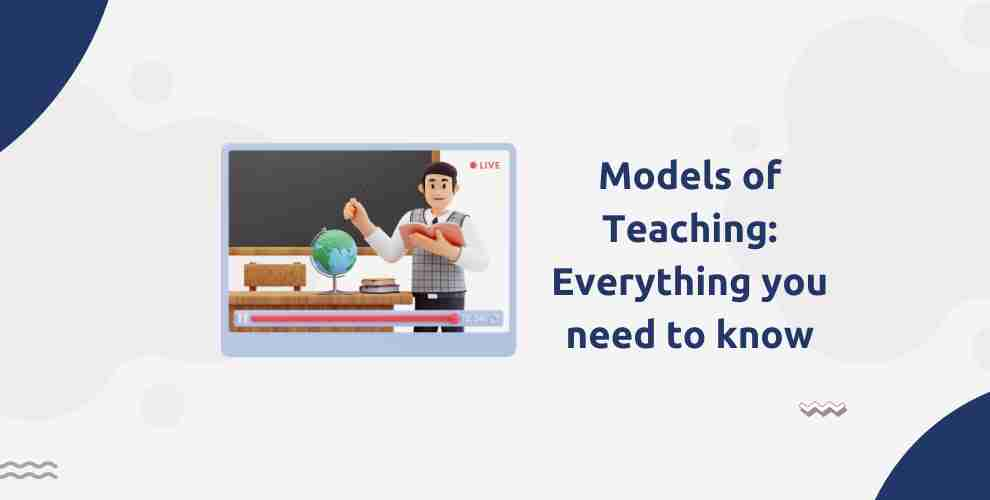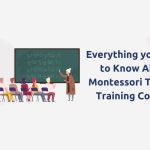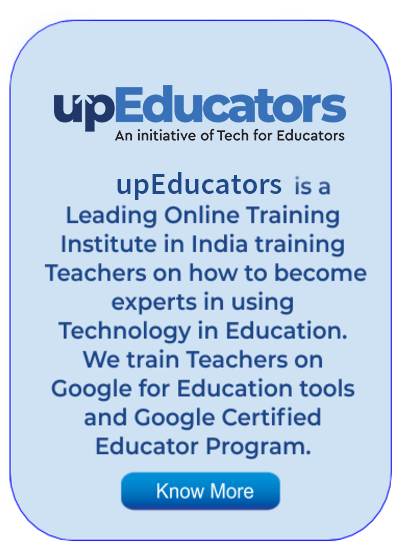Ms Shruti was an experienced teacher who had been teaching for over ten years at the same school. Although she loved teaching, she had been struggling to engage and motivate her students in recent times. Despite her best efforts, her students seemed disinterested in the classroom, and their grades were suffering. Ms Shruti tried different approaches, including interactive lectures and group discussions, but they didn’t work. While browsing online, Ms Shruti discovered the flipped classroom approach, which involved providing pre-recorded video lectures for students to watch at home, leaving class time for collaborative activities and discussions. Ms Shruti decided to try this approach, and it worked wonders. The students were more engaged and asked more questions, and their grades improved significantly. Ms Shruti continued to use the flipped classroom approach in her lessons, and her students continued to thrive under her guidance.
Using different models of teaching can help teachers improve the learning experience for their students. In today’s rapidly evolving education landscape, there are various models of teaching. From the traditional lecture-based approach to the more contemporary student-centred approach, each model has its unique strengths and limitations.

Importance of Models of Teaching
Using different models of teaching in the classroom is significant for several reasons.
- Firstly, it caters to different learning styles, allowing students to engage with the material in a way that best suits them.
- Secondly, it helps teachers to be more flexible in their approach, adapting to the needs of their students and the demands of the curriculum.
- Additionally, using different teaching models encourages critical thinking, problem-solving, and collaboration, which are essential skills for success in today’s world.
- Finally, it keeps the classroom environment dynamic and engaging, preventing students from becoming bored or disengaged. In short, incorporating various teaching models can enhance the learning experience for students and make the teaching process more effective and enjoyable for both students and teachers.
Different types of Models of Teaching
There are different types of models of teaching that can help to cater to the diverse needs and learning styles of students. Each model has its own strengths and limitations, and the choice of the model depends on various factors, including the subject matter, the student’s level, and the learning objectives. Let us look at some of the most commonly used models of teaching.
Direct Instructional Model
Direct Instruction is a teacher-centred model of teaching that involves the teacher delivering content through lectures, demonstrations, or other instructional methods. The goal of this method is to provide students with clear, structured, and organized lessons that cover specific learning objectives.
One example of direct instruction is a math teacher explaining the steps for solving a particular problem. The teacher may use visual aids or diagrams to illustrate the concept and then demonstrate how to apply it to a problem. The teacher may also use questions and answers to check students’ understanding and reinforce key concepts.
Direct instruction can be effective for teaching foundational knowledge and skills, particularly in subjects like math and science. It can also be helpful for students who need explicit instruction and structure to learn effectively.
Inquiry-Based Learning Model
Inquiry-based learning is a student-centred approach to teaching and learning that emphasizes curiosity, exploration, and critical thinking and helps develop 21st-century skills of knowledge construction. In this approach, students are encouraged to ask questions, investigate, and draw their conclusions through research, experimentation, and problem-solving.
For instance, a teacher might ask students to investigate the factors that affect the growth of plants and assign them to design and conduct experiments to test different hypotheses. Through this process, students develop critical thinking, problem-solving, and research skills, and they gain a deeper understanding of the subject matter.
Inquiry-based learning can be effective in promoting student engagement, autonomy, and creativity. It also allows students to develop essential skills that go beyond subject-specific knowledge, such as teamwork, communication, and critical thinking.
Cooperative Learning Model
Cooperative learning is a teaching model that emphasizes collaboration and teamwork among students and helps develop 21st-century skills of collaboration. In this approach, students work in small groups to achieve a common learning goal, where each member has a specific role and responsibility.
An example of cooperative learning in the classroom is a language teacher who divides the class into small groups and assigns each group a topic to research and present to the class. Each student in the group has a specific task, such as researching, writing, editing, or presenting. Students then work together to complete their tasks, share their ideas and knowledge, and provide feedback to each other. In this way, students can develop their language skills, critical thinking, problem-solving, and teamwork abilities.
Cooperative learning can be effective in promoting student engagement, social skills, and a sense of belonging. It also allows students to learn from each other and gain a different perspective on the subject matter.
Flipped Classroom Model
Flipped classroom is a teaching model that involves students watching pre-recorded lectures or presentations at home and then engaging in collaborative activities and discussions during class time. The aim is to provide students with more opportunities for active learning and to allow teachers to personalize their instruction.
An example of the flipped classroom in classroom is a math teacher who records a video lesson explaining a complex concept and uploads it to an online platform accessible to students at home. Students are required to watch the video lecture before coming to class, and the teacher then leads students through activities such as problem-solving exercises, group discussions, or peer-to-peer tutoring. In this way, students can engage in active learning, and the teacher can provide more targeted and individualized feedback to each student.
Flipped classroom teaching can be effective in promoting student engagement, collaboration, and critical thinking. It also allows teachers to personalize their instruction to meet the diverse needs of their students.
Blended Learning Model
Blended learning is a teaching model that combines traditional classroom instruction with online learning, where students can access educational content and complete activities using technology. The aim is to provide students with a flexible and personalized learning experience that combines the best of both worlds.
An example of blended learning in the classroom is an English teacher who assigns reading materials and grammar exercises to be completed online. Students can access the materials and complete the exercises at their own pace, using a computer or a mobile device, either in or outside the classroom. The teacher can then use class time to engage students in discussion, debate, or language practice activities that build on the online materials. In this way, students can benefit from both the convenience and flexibility of online learning and the social interaction and feedback that come with traditional classroom instruction.
Blended learning can be effective in promoting student engagement, motivation, and independence. It also allows teachers to differentiate instruction and personalize learning to meet the diverse needs of their students.
Different models of teaching offer a variety of approaches to help educators meet the diverse needs of their students. Each model has its strengths and weaknesses, and the choice of which model to use depends on the learning objectives, the student’s needs and preferences, and the resources available. Whether it’s using the direct instructional method to deliver structured lessons, inquiry-based learning to promote critical thinking, cooperative learning to foster teamwork and collaboration, flipped classrooms to provide active learning or blended learning to offer a personalized and flexible approach, teachers can find the right model to engage and motivate their students and support their academic success.
If you want to integrate these models of teaching in your classroom, then a Professional Certificate in Innovative Teaching Practices Course by upEducators can help you in learning and implementing these different models of teaching in the classroom.
Author: This article is written by Samiya Rashid for upEducators blog.




